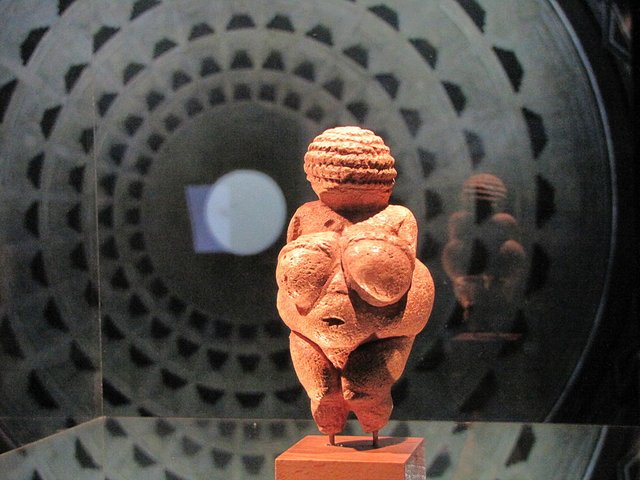Venus from Willendorf
The Venus of Willendorf is one of the most famous and oldest artefacts in the world. The most famous prehistoric representation of the woman was discovered on August 7, 1908 by one of the workers who participated in the excavations that were begun a few days earlier in Willendorf, Austria, led by Josef Szombathy. Though it is almost 30,000 years old, its naked image still awakens admiration and interest. It is considered one of the oldest works of art.

The figurine measures 11 cm in height, it is made of limestone (not present in this area) and painted with red ocher. The red color is a symbol of both blood and life forces. The time of its creation was set at around 22,000 - 24,000 BC, but the researchers do not agree. The figurine is a representation of a woman with a very prominent bust, an enlarged belly and short legs with strongly developed thighs, which were attributes of the mother-woman's fertility. Its distinctive details are: ornate hairstyle or a headgear consisting of seven rows of forms reminiscent of small curls and frail, bust-folded hands, most of which are similarly deprived of statuettes. Currently, this type of figurines are classified by archeologists as so-called venetian venus. They were made in the period of 25,000-18.000 BC, of stone (limestone, tuff or flint) of clay, horn or jet bone. They are characterized by a schematic outline of the head, small arms, rudimentary feet at a very large body. As a rule, characters are heavily stylized to emphasize the characteristics of sex and the value of motherhood: with supernatural luxuriant breasts and buttocks. Figures also have a distinct axis of vertical and lateral symmetry, which gives them a spindle-shaped form. As it was believed, they were associated with the cult of fertility and deity, taking care of women during pregnancy and delivery.
Since its discovery, Venus of Willendorf has become the most famous prehistoric sculpture. The Venus of Willendorf gained great fame because it was one of the first discovered works of high-class prehistoric art. Her picture opens almost every textbook of art history. Currently, the figurine is part of the Naturhistorisches Museum in Vienna.
I'm very impressed,
AdaZone
PL🇵🇱
Wenus z Willendorfu
Wenus z Willendorfu to jeden z najsłynniejszych i najstarszych artefaktów świata. Najsłynniejsze prehistoryczne przedstawienie kobiety zostało odkryte 7 sierpnia 1908 r. przez jednego z robotników uczestniczących w rozpoczętych kilka dni wcześniej wykopaliskach w miejscowości Willendorf w Austrii, którymi kierował Josef Szombathy. Choć ma prawie 30 000 lat jej nagi wizerunek do dzisiaj wzbudza zachwyt i zainteresowanie. Jest uznawany za jedno z najstarszych dzieł sztuki.

Figurka mierzy 11 cm wysokości, wykonana jest z wapienia (niewystępującego w tej okolicy) i pomalowana czerwoną ochrą. Czerwony kolor jest symbolem zarówno krwi, jak i sił życiowych. Czas jej powstania został określony na około 22.000 - 24.000 p.n.e., lecz naukowcy nie są zgodni. Figurka jest przedstawieniem kobiety o bardzo wydatnym biuście, rozrośniętym brzuchu i krótkich nogach o silnie rozwiniętych udach, które to cechy były atrybutami płodności kobiety-matki. Wyróżniającymi ją detalami są: ozdobna fryzura lub też nakrycie głowy złożone z siedmiu rzędów form przypominających drobne loczki oraz wątłe, złożone na biuście ręce, których większość podobnych statuetek jest ich pozbawiona. Obecnie figurki tego rodzaju klasyfikowane są przez archeologów jako tzw. wenus paleolityczna. Wykonywano je w okresie 25.000-18.000 p.n.e., z kamienia (wapienia, tufu lub krzemienia) kości gliny, rogu bądź gagatu. Odznaczają się schematycznym zarysem głowy, drobnymi ramionami, szczątkowo zarysowanymi stopami przy bardzo rozbudowanym korpusie. Z reguły postacie są silnie wystylizowane w celu podkreślenia cech płci i wartości macierzyństwa: z nadnaturalnie bujnym biustem i pośladkami. Figurki odznaczają się również wyraźną osią symetrii pionowej i poprzecznej, co nadaje im wrzecionowatą formę. Jak się uważa wiązały się z kultem płodności i bóstwa sprawującego opiekę nad kobietami w okresie ciąży i porodu.
Od czasu jej odkrycia, Wenus z Willendorfu stała się najbardziej znaną prehistoryczną rzeźbą. Wenus z Willendorfu zdobyła wielką sławę, gdyż była jednym z pierwszych odkrytych dzieł sztuki prehistorycznej wysokiej klasy. Jej zdjęcie otwiera prawie każdy podręcznik historii sztuki. Obecnie figurka stanowi część zbiorów Naturhistorisches Museum w Wiedniu.
Ja jestem pod wrażeniem,
AdaZone
admiration and interest.
Thank you @withsmn! Have a nice day! 😊👍
The look of the sculpture has always interested me. Its funny to think how much details of this may have been lost to degradation over the years. Good writing!
It's really interesting, thank you and I invite you to more often visiting my blog @adazone 😊👍
Congratulations @adazone! You have completed the following achievement on Steemit and have been rewarded with new badge(s) :
Click on the badge to view your Board of Honor.
If you no longer want to receive notifications, reply to this comment with the word
STOPTo support your work, I also upvoted your post!